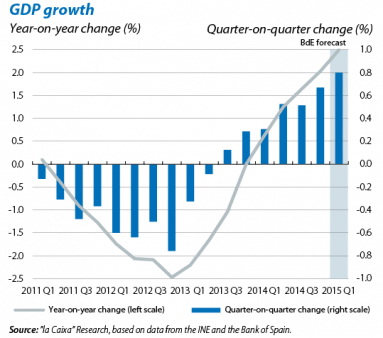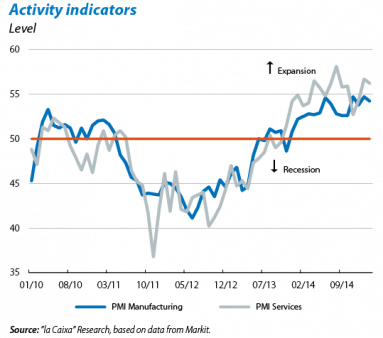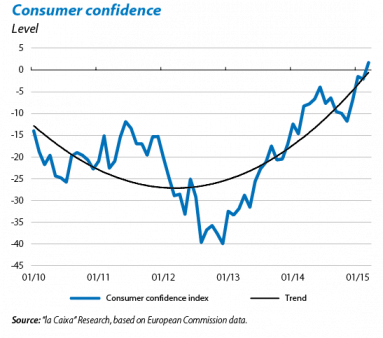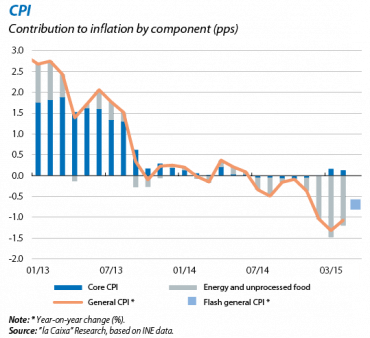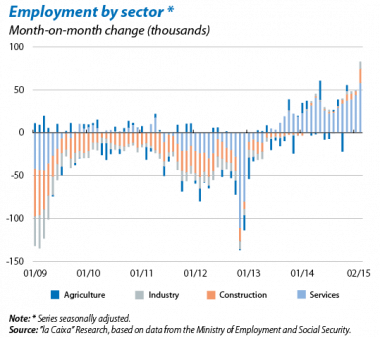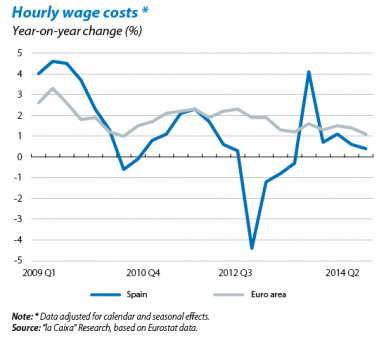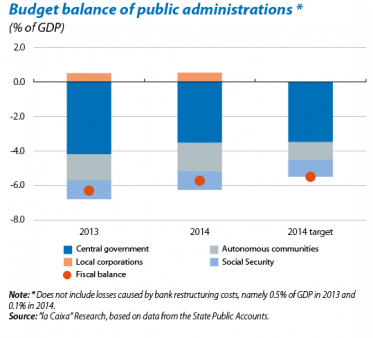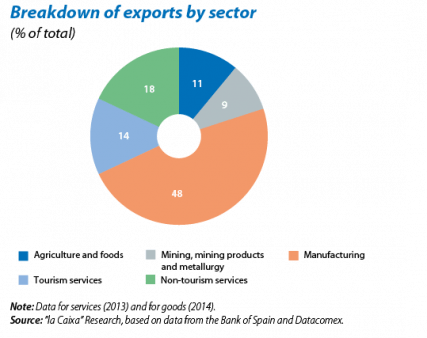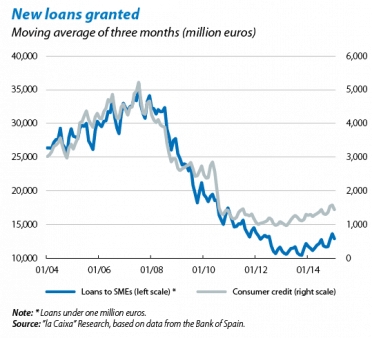Spain consolidates its recovery
The pace of growth speeded up slightly in Q1. According to the Bank of Spain (BdE), GDP grew by 0.8% quarter- on-quarter in 2015 Q1 (0.7% in 2014 Q4). Following the pattern of preceding quarters, domestic demand would have continued to be the driving force behind this rate of recovery, contributing 0.9 pps to growth, while exports would have made a slightly negative contribution (–0.1 pps). For the whole of the year, the BdE has revised upwards its GDP growth forecast to 2.8%, 0.8 pps higher than its forecast in December, placing the growth forecast for 2016 at 2.7%. This notable revision of growth prospects is due to expected improvements in the foreign sector thanks to the positive effect of QE on the euro area's growth prospects. It will also be boosted by the strength of support factors that have entered the scene more recently, such as improved financing conditions, lower oil prices and the euro's depreciation. However, as the European Commission repeated in its in-depth report on macroeconomic imbalances in the Spanish economy, for this good rate of growth to continue in the long term the country must continue to carry out external adjustments, fiscal consolidation and structural reforms.
Good growth prospects spur on corporate investment. Supply indicators available since the start of the year point to capital goods investment growing at a good rate in Q1, encouraged by a climate of optimism and confidence regarding the future trend in activity. Specifically, the composite PMI for January and February stood, on average, at 57.8 points (54.5 points in 2014 Q4), representing a comfortable expansionary zone. The same interpretation of sustained recovery in investment can be deduced from the figures for industrial orders, whose year-on-year rate of change stood at 2.2% in January (2.0% on average in Q4), with the increase in orders of capital goods being particularly strong. By geographical zone, the rise in industrial orders in the domestic market (2.7% year-on-year) and in the euro area (3.8% year-on-year) is yet another example of the strength in domestic demand and that the euro area's recovery is starting to boost the Spanish economy.
Good figures for consumption indicators. Judging by the growth in retail and consumer goods, namely 3.0% year-on-year in January (2.9% in Q4) and by the notable increase in consumer confidence, rising to –0.6 points on average in Q1 (–9.6 in Q4), private expenditure continued to grow apace in Q1. Since the start of the recovery, household consumption has risen above its disposable income, thereby reducing the savings rate: in 2014 this stood at 9.7%, representing a decrease of 0.7 pps compared with 2013 and 5.6 pps compared with the peak reached in 2009 Q4 (15.3%). One factor that is probably helping to reduce savings in this phase of the recovery is the fact that, as economic prospects improve and uncertainty declines regarding the trend in the labour market, families will have started to use the financial assets accumulated as a precautionary measure during the years of recession.
The fall in prices is slowing up, in line with our forecast of a gradual recovery. Inflation rose by 0.4 pps in March, up to –0.7% year-on-year. Over the coming months we expect the moderate rise in oil prices, improved domestic demand and the euro's depreciation to push up inflation even further.
The labour market reflects the good performance of economic activity. The number of workers affiliated to Social Security increased above expectations in February (86,000 in monthly terms, seasonally adjusted). In addition to the dynamism shown by the services sector, which has been performing positively for several months now, significant acceleration can also be seen in the rate of jobs created in industry and especially in construction. The recovery of employment in construction, whose year-on-year rate of change rose in February by 1.7 pps to 5.1%, is clear proof of the change in trend in the real estate sector. Judging by the employment expectations of the European Commission's opinion polls, the labour market's recovery will continue its positive trend over the next few months.
Reform of the training system for the unemployed. The government has passed the Royal Decree-Law 4/2015 to improve the effectiveness, coordination and transparency of vocational training for the unemployed. From now on, trade unions and owner organisations will not be able to give training courses and their function will focus on planning and programming the training available. Also important is the fact that subsidies for training courses will now be put to open tender with mandatory audits for external control. A «training cheque» was also established so that unemployed people can choose the centre where they wish to train. Another important innovation is the creation of a «worker training account», certifying a worker's training record, a very useful tool for more personalised training guidance. As a whole, these measures should resolve some of the shortcomings in the current system and respond better to the training needs of both individuals and business.
Wage containment continues to support gains in competitiveness. According to the harmonised index of labour costs, wage costs in Spain rose by 0.4% year-on-year in 2014 Q4 compared with 1.1% year-on-year in the euro area. This limited growth by wages did not result in a loss of purchasing power for Spanish consumers as inflation was in negative figures but it did help the country to continue making gains in competitiveness compared with the euro area. The fact that, in February, the wage levels in collective agreements increased by a moderate 0.7% year-on-year suggests that wage containment probably continued in Q1. On the other hand, it should be noted that, in addition to wage containment, the decrease in the number of dismissals has also helped to reduce the overall labour costs of firms, improving their growth capacity. Specifically, non-wage payments (mostly redundancy pay and severance packages) fell by 18.3% year-on-year in 2014 Q4.
The public sector ends 2014 with a deficit of 5.7% of GDP, slightly off the target (5.5%). By administration, of note is the public administration deviation from the target (1.7% compared with the 1.0% target), partly offset by the surplus achieved by local government corporations (–0.5% compared with the 0% target). Both central government and Social Security deviated very slightly, although the latter used 15.3 billion euros from the Reserve Fund in 2014. The target deficit for 2015 (4.2%) entails a reduction of 1.5 pps. Although the significant improvement in the economic cycle expected for this year will help to improve public administration accounts, the authorities must continue with their efforts to reduce public deficit and ease the burden of public debt.
The diversification of exports will aid the foreign sector. The breakdown in total exports by sector reveals considerable diversification in Spanish exports which, in turn, reflects the fact that the efforts being made to internationalise Spanish firms are affecting a range of sectors and a wide variety of products. The most evident change has occurred in the services sector where the share of non-tourism services (18%) now more than outweighs tourism services (14%). Throughout the year we expect exports to become stronger, boosted by the improved performance of foreign markets and the euro's depreciation. The tourism figures support this prediction: between January and February 6.5 million foreign tourists came to Spain, a year-on-year increase of 4.5%. However, the figures for goods exports in January were less encouraging, halting the improvement that had begun at the end of 2014. Nonetheless it should be noted that the monthly data for goods exports are highly volatile and projections for the coming months are still favourable.
Bank credit adds to the recovery. In January the number of new loans granted continued to reflect the upward trend starting in 2014, with significant growth in credit to households and SMEs. The breakdown by segment for Q4 shows a lower rate of contraction in outstanding credit thanks to the good performance of some segments such as loans for consumption and financial services, offsetting the notable declines still being seen for construction and real estate developers. Regarding the restructuring of Spain's banking system, the European Commission and the ECB, in their third supervisory visit after the end of the banking sector restructuring programme, valued positively the most recent reforms in the sector such as the recent appointment of Spain's bank recapitalisation fund (FROB) as the national resolution authority and the progress made in implementing the restructuring plans for banks receiving public aid.
